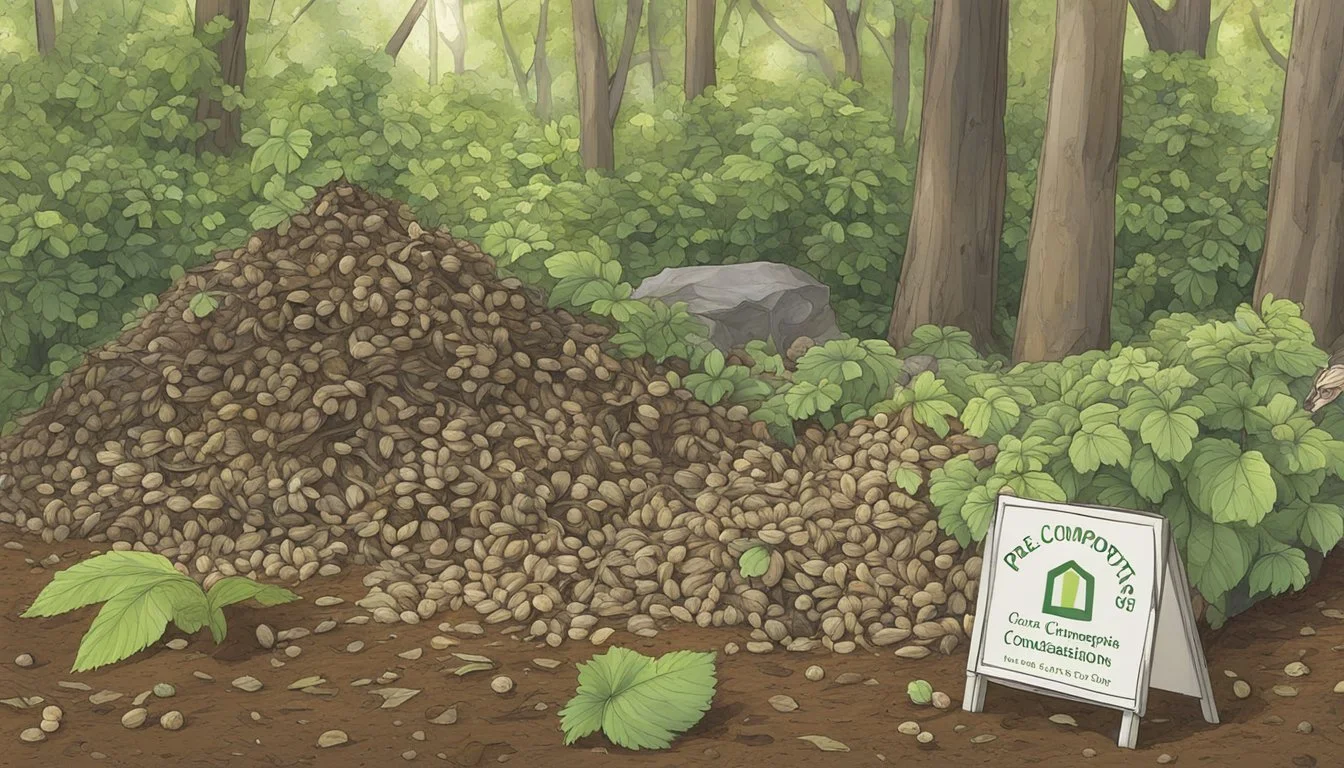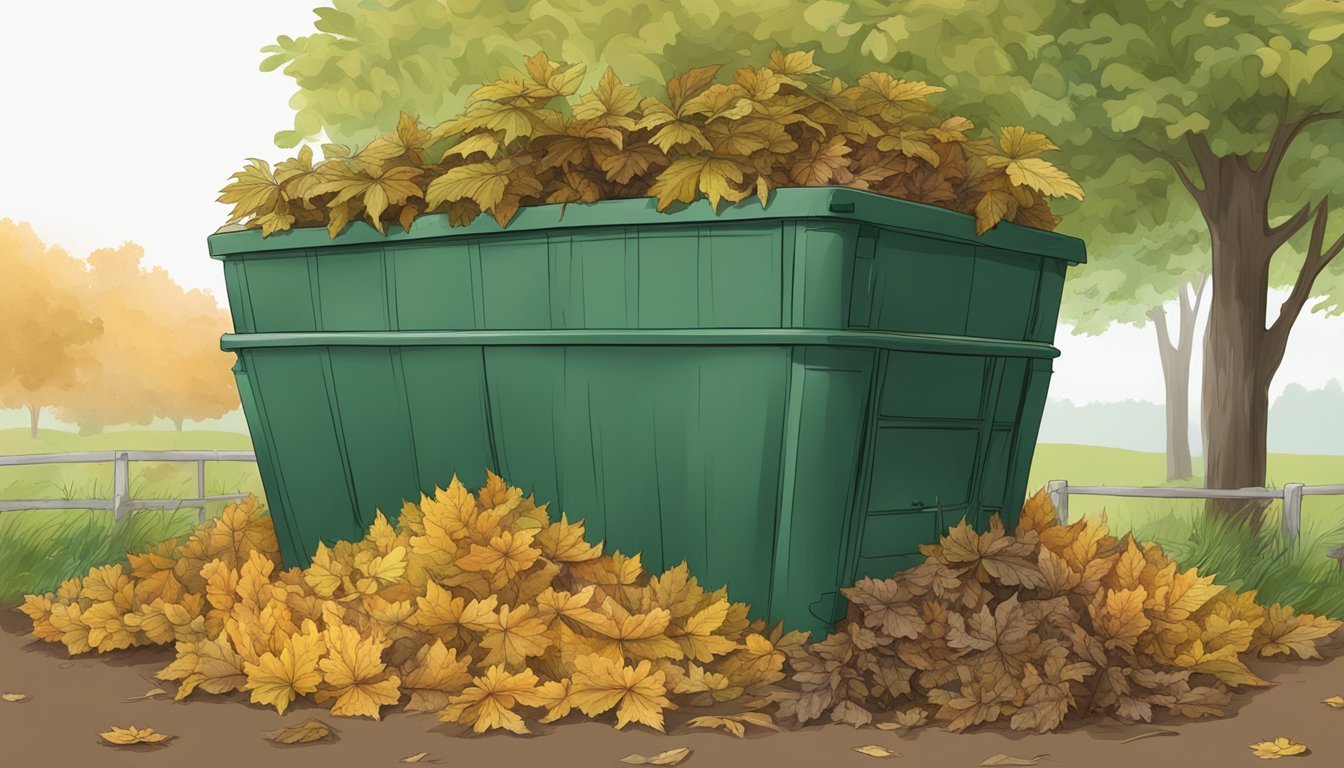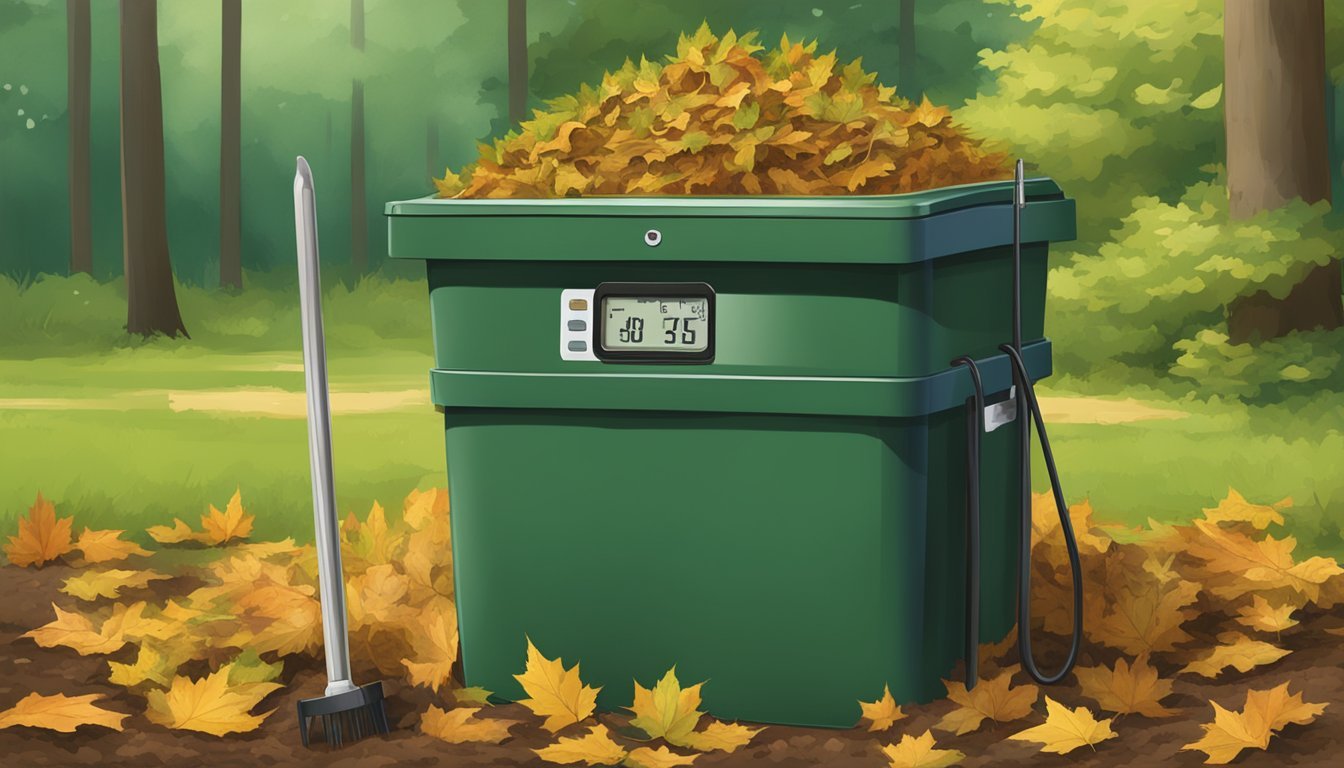Can You Compost Horse Chestnut Leaves?
Understanding Their Impact in Compost Piles
Composting is a widely-practiced method of recycling organic material, such as leaves, into a rich soil amendment that benefits garden health. Amidst the variety of leaves that fall each autumn, one may question whether the leaves of the horse chestnut tree are suitable for this eco-friendly process. The horse chestnut, distinguishable by its broad, palmate leaves and spiky fruit husks, is often considered problematic in composting due to certain compounds it contains.
Many gardeners exercise caution when adding horse chestnut leaves to their compost piles. These leaves contain compounds that can be deleterious to plant growth when not fully decomposed. As a result, they may require a longer period to break down and should not be used in compost that will nourish edible crops.
However, it's not all discouraging for those who have an abundance of horse chestnut leaves. With the appropriate composting method and patience, it's possible for these leaves to be repurposed effectively in certain gardening contexts. Their use may be more appropriate for non-edible plants, ornamental gardens, or as a mulch, once they have decomposed adequately.
Understanding Compost
In the world of garden waste management and soil health, composting stands out as a transformative process. Let's explore how composting works and the specific benefits of including horse chestnut leaves in your compost pile.
Basics of Composting
Composting is the natural process of recycling decomposed organic matter, such as leaves, into a rich soil amendment known as compost. At the heart of this process are microbes, including bacteria and fungi, which break down the organic material. For effective composting, the pile needs a balanced mix of 'greens' (nitrogen-rich materials) and 'browns' (carbon-rich materials), adequate moisture, and aeration.
Properly managed, a compost pile converts organic waste into nutrient-rich compost over time. This finished product contains vital nutrients like nitrogen, potassium, and phosphorus, necessary for plant growth.
Benefits of Composting Horse Chestnut Leaves
Horse chestnut leaves can be composted, but they require special consideration due to their specific properties:
Decomposition: They break down at a different rate compared to other leaves, which should be accounted for in the composting process.
Nutrients: When horse chestnut leaves decompose, they add valuable organic matter to the compost, beneficial for soil health and structure.
It is important to note that one should introduce horse chestnut leaves into compost in moderation and ensure they are well mixed with other compostable materials to aid in their breakdown and to mitigate any potential negative effects on the final compost quality.
Pre-Composting Considerations
Before adding any type of leaves to a compost pile, it's important to recognize that not all tree leaves are suitable for composting due to the presence of toxins or growth inhibitors. A balanced combination of nitrogen, carbon, moisture, and oxygen is also crucial to ensure successful decomposition.
Identifying Safe and Toxic Tree Leaves for Compost
Certain tree leaves, such as those from the horse chestnut and black walnut, contain compounds that can be toxic to other plants. Horse chestnut leaves contain compounds that can slow down the decomposition process, while black walnut leaves contain juglone, a substance detrimental to the growth of many plant species. In contrast, leaves from trees like oak are generally safe for compost and can contribute to a nutrient-rich end product.
The Role of Nitrogen and Carbon in Composting
For optimal composting conditions, it's important to maintain a good balance between nitrogen-rich materials, like green leaves and kitchen scraps, and carbon-rich materials, such as dry leaves and wood chips. An often recommended ratio is 1 part by volume green material (nitrogen) to 30 parts brown material (carbon). This ensures that microbes have the right environment to break down the matter effectively.
Moisture and Oxygen: Essential for Compost Health
Composting requires adequate moisture and oxygen to support the microorganisms responsible for decomposition. The compost pile should be moist but not waterlogged, with a humidity equivalent to a wrung-out sponge. Proper aeration through regular turning introduces oxygen, preventing anaerobic conditions which can lead to foul odors and slowed decomposition.
Composting Horse Chestnut Leaves
Horse chestnut leaves can be composted, but they require special attention to manage potential toxins and encourage decomposition. Proper shredding and composting conditions are essential.
Ways to Shred Leaves for Faster Decomposition
Shredding: Horse chestnut leaves should be shredded to accelerate the composting process. Shredder or mower can be used to chop the leaves into smaller pieces. Finely shredded leaves decompose more quickly than whole leaves as they offer more surface area for composting microbes to work on.
Manual shredding: Using a rake and running a lawn mower over the collected leaves.
Mechanical shredding: Utilizing a leaf shredder to produce uniform shreds.
Managing Potential Toxins in Horse Chestnut Leaves
While horse chestnut leaves contain certain compounds that might be toxic to other plants, proper composting techniques can minimize these effects. It is crucial to ensure that the compost pile maintains a good balance between green and brown materials, which helps in breaking down possible toxins. Regularly turning the compost helps aerate the pile and distribute microbes that neutralize harmful substances.
Optimal Conditions for Composting Horse Chestnut Leaves
The compost pile should be managed to retain warm temperatures and sufficient moisture levels to improve decomposition rates. Horse chestnut leaves, rich in lignin, require a longer time to break down. Microbial activity is paramount, which can be optimized by:
Aeration: Turning the compost pile regularly to provide oxygen.
Moisture: Keeping the pile moist, but not wet, to support microbial life.
Balance: Mixing horse chestnut leaves with a variety of other compostable materials, including nitrogen-rich green waste, to balance the carbon-to-nitrogen ratio.
Building a Successful Compost Pile
Creating a thriving compost pile involves careful layering and maintaining the right balance of materials to ensure efficient decomposition. The goal is to transform organic waste into a nutrient-rich amendment for gardens.
Layering Your Compost Pile
A well-structured compost pile consists of alternating layers of green and brown materials. The green materials provide nitrogen, essential for the microbial activity that breaks down organic matter. These include grass clippings, garden trimmings, and vegetable scraps. In contrast, brown materials, such as dry leaves, straw, and wood chips, supply carbon, which fuels the microbes and adds bulk to the pile. A simple layering formula involves adding equal parts of greens and browns, ensuring each layer is uniformly spread to avoid clumping.
Example Layering Structure:
Bottom Layer: Twigs and branches for aeration
Second Layer: Brown materials (dry leaves, straw)
Third Layer: Green materials (vegetable scraps, grass clippings)
Additional Layers: Repeat the second and third layers, alternating
It's crucial to avoid including leaves from trees that may contain harmful substances, such as horse chestnut, which can inhibit plant growth. These should not be added to the pile.
Maintaining the Right Balance of Ingredients
The efficiency of a compost pile hinges on the proper balance of moisture, aeration, and the ratio of green to brown materials. The pile should remain moist, like a wrung-out sponge, to support microbial life without becoming waterlogged. Regular turning of the pile integrates the layers, provides oxygen, and speeds up decomposition. If a pile is too wet, adding more brown materials can help absorb excess water. Conversely, if it's too dry, adding water or green materials can reintroduce the necessary moisture.
To monitor this balance:
Moisture: Check with a touch; the pile should be damp but not dripping.
Aeration: Turn the pile regularly with a fork or shovel.
By adhering to these guidelines, one can ensure their compost becomes a viable and effective asset for enriching garden soil.
Special Considerations for Tree Leaves
When composting tree leaves, one must consider varied decomposition rates and the potential for high acidity or toxins. Selecting appropriate leaf varieties is crucial for a successful and balanced compost.
The Different Decomposition Rates of Leaf Varieties
Decomposition rates can drastically affect compost balance. For example:
Fast Decomposing Leaves: These typically include maple, poplar, and willow leaves.
Slow Decomposing Leaves: Leaves from oak, beech, and horse chestnut trees decompose more slowly due to their higher lignin content.
When composing your pile, a mixture of fast and slow decomposing leaves will create a balanced compost over time.
Addressing High Acidity and Toxins in Certain Leaves
Certain leaves contain chemicals that can be harmful to compost piles:
Juglone: A chemical found in black walnut leaves, harmful to many plants.
Eucalyptol: Present in eucalyptus leaves, it can suppress the composting process.
Additionally, leaves from fruit trees and cherry trees tend to be more acidic, which can require balance with more alkaline materials. One should exclude horse chestnut and eucalyptus leaves, as they contain compounds that can inhibit plant growth or harm beneficial composting organisms.
Using Composted Leaves in Gardening
Composted leaves are a valuable amendment in gardening, providing benefits such as soil nutrition enhancement and effective mulching. Utilizing this organic matter can significantly contribute to a healthier garden ecosystem.
As Mulch for Plants and Flowerbeds
Using leaf compost as mulch around plants and in flowerbeds offers several advantages. It retains soil moisture, suppresses weeds, and provides a slow release of nutrients as it breaks down. A layer of 2-3 inches is typically sufficient to reap these benefits without smothering the plants.
Enhancing Soil Nutrition with Leaf Compost
Leaf compost is rich in minerals that are essential for plant growth, including nitrogen, phosphorus, and potassium. When mixed into garden soil, it improves soil structure, increases nutrient content, and enhances microbial activity, thus providing a robust foundation for plant development.
Compost as a Lawn Conditioner
Composted leaves can be used as a natural lawn conditioner. When applied to the lawn, the compost helps to aerate the soil, facilitating better water retention and promoting a lush, healthy turf. It acts as a soil conditioner, invigorating the lawn and aiding in the proliferation of beneficial microorganisms.
Troubleshooting Common Composting Challenges
Effective composting relies on maintaining a balanced ecosystem within the compost pile. This section addresses challenges such as pest attraction, unwanted odors, and pH imbalances that can affect the health of your compost.
Dealing with Pests and Mold in Compost
When compost attracts pests or develops mold, it is often due to excess moisture or the presence of materials like meat, dairy, and oils that should not be included. Fungi and weed seeds can also survive in poorly managed piles.
Regularly turn the compost: Aeration discourages anaerobic conditions where mold flourishes.
Add brown materials: Incorporate cardboard, leaves, or straw to absorb excess moisture.
Maintaining a proper mix of 'greens' (nitrogen-rich materials) and 'browns' (carbon-rich materials) alongside frequent turning should eliminate most pest and mold issues.
Preventing Smelly Compost Piles
Unpleasant odors usually indicate an imbalance in the compost, often from a lack of oxygen or too much green material.
Balance the compost: Ensure that there is an adequate amount of brown materials to offset the greens.
Ensure good aeration: Turn the pile to introduce oxygen and accelerate decomposition.
Sometimes piles become too wet, exacerbating the problem. Covering the compost or adding dry materials helps absorb the moisture that contributes to the smell.
Adjusting pH Balance in Compost
An optimal pH, usually between 6 and 7.5, is crucial for microorganisms to break down organic materials effectively. Animal manure or acidic fruit waste can alter the pH balance.
Test the pH: Regularly check compost pH to monitor acidity or alkalinity.
Add garden lime: If the compost is too acidic, adding garden lime can help bring the balance back to neutral.
Balancing the ingredients in your compost, including the occasional addition of gardener's lime or wood ash for overly acidic compost, will help maintain the ideal pH level for composting.
Tools and Techniques for Efficient Composting
To achieve efficient composting, one must carefully consider the type of composter, the process of breaking down materials, and the methods employed to transform waste into a valuable resource.
Choosing the Right Compost Bin or System
Fixed Compost Bins: Generally made from wood or plastic, fixed bins are ideal for gardeners with sufficient space. These bins should be set up in a shaded, dry area to protect the composting material from excess moisture.
Rotating Compost Bins: These bins are designed to be turned regularly, ensuring a consistent mix and faster decomposition. They are particularly useful for gardeners who prefer a tidier appearance and aim for quicker compost turnover.
Shredding and Turning: Keys to Fast Decomposition
Shredding: Reducing the size of composting materials such as horse chestnut leaves accelerates the decomposition process. Gardeners can use a shredder or a simple pair of scissors to achieve the desired size.
Turning: Regular turning is critical for aeration and speeding up the composting process. One should turn their compost pile every 1-2 weeks using a shovel or pitchfork to ensure evenly distributed decomposition.
Traditional vs. Innovative Composting Methods
Traditional Composting Methods: Often rely on the natural breakdown of organic matter over time. A traditional heap requires manual turning and can take longer to produce compost.
Innovative Composting Methods: Include techniques that may speed up the process. These include using tumblers for more effective aeration and adding a compost starter to introduce beneficial microbes, expediting the breakdown of organic matter.
Embracing Composting As Part of Garden Lifestyle
Gardeners find joy and simplicity in integrating composting practices into their garden life. This section outlines how one can learn more about composting and how it contributes to the enjoyment of cultivating a thriving garden ecosystem.
Educational Resources and Getting Support
Gardeners looking to elevate their composting skills have a variety of educational resources at their disposal. They may seek guidance from a multitude of ebooks and websites dedicated to composting techniques and strategies. It’s crucial for gardeners to leverage these platforms which often offer step-by-step instructions and can connect them with affiliated products that enhance the composting process. Community forums and local gardening groups can also provide invaluable support and advice, strengthening a gardener's knowledge and confidence.
The Enjoyment of Creating Your Own Compost
Creating compost is a fulfilling aspect of garden life. Gardeners who embrace composting often find it an enjoyable activity that enriches their garden soil and plant health. The process of transforming kitchen scraps and yard waste into nutrient-rich compost not only benefits the garden itself but also instills a sense of accomplishment. The tangible results of composting reinforce its value, making it an essential and satisfying component of a gardener's routine.










